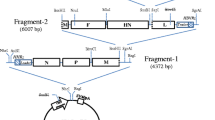Abstract
A rapid biological assay based on incubation time has been developed for determination of the potency of Newcastle disease virus strain I-2 vaccine. It is based on the observation that the interval between inoculation and the first detection of haemagglutinin (HA) depends on the titre of the vaccine inoculated. Chicken embryonated eggs were inoculated with different titres (109, 106 and 103 EID50/0.1 ml) of vaccine and incubated for 24 h. At hourly intervals, 5 eggs from each vaccine titre were tested for the presence of HA. The results showed that the HA activity was detected from 5, 11 and 15 h after inoculation with vaccine doses of 109, 106 and 103 EID50, respectively. On the basis of these results it is suggested that if there is no HA detected from 5 to 11 h after inoculation of eggs with the vaccine virus, the vaccine should not be used to vaccinate chickens as it might have an infectivity titre of less than 106 EID50/0.1 ml, which is equivalent to the recommended single chicken dose. It is concluded that measuring the time between inoculation of the vaccine virus and the onset of HA activity might provide an estimate of the titre of the vaccine within 24 h.
Similar content being viewed by others
Abbreviations
- EID50 :
-
median embryo infectious dose
- HA:
-
haemagglutinin, haemagglutination
- ND:
-
Newcastle disease
- NDV:
-
Newcastle disease virus
References
Alders, R. and Spradbrow, P.B., 2001. Controlling Newcastle disease in village chickens: a field manual. ACIAR Monograph, 82, 41
Alexander, D.J., 1988. Newcastle disease diagnosis. In: D.J. Alexander (ed.), NewcastleDisease, (Kluwer Academic, Boston), 145–160
Alexander, D.J., 1998. Newcastle disease. In: D.E., Swayne, J.R. Glisson, M.W., Jackwood, J.E., Pearson, and W.M., Reed, (eds.), A Laboratory Manual for Isolation and Identification of Avian Pathogens, 4th edn, (American Association of Avian Pathologists, Kennett Square, PA), 156–163
Bensink, Z. and Spradbrow P., 1999. Newcastle disease virus strain I-2—a prospective thermostable vaccine for use in developing countries. Veterinary Microbiology, 68, 131–139
Cargill, P., 1999. Vaccine administration in poultry. In Practice, 21, 323–328
Meulemans, G., 1988. Control by vaccination. In: D.J. Alexander (ed.), Newcastle Disease, (Kluwer Academic, Boston), 318–332
Spradbrow, P.B. and Copland, J.W., 1996. Production of thermostable Newcastle disease virus in developing countries. Preventive Veterinary Medicine, 29, 157–159
Spradbrow, P.B., Mackenzie, M. and Grimes, S.E., 1995. Recent isolates of Newcastle disease virus. Veterinary Microbiology, 46, 21–28
Thorntorn, D.H., 1988. Quality control of vaccines. In: D.J. Alexander (ed), Newcastle Disease, (Kluwer Academic Publishers, Boston), 347–365
Author information
Authors and Affiliations
Corresponding author
Rights and permissions
About this article
Cite this article
Wambura, P.N., Meers, J. & Spradbrow, P. Development of a rapid biological assay for determination of potency of Newcastle disease vaccine (strain I-2). Trop Anim Health Prod 38, 463–466 (2006). https://doi.org/10.1007/s11250-006-4335-2
Accepted:
Issue Date:
DOI: https://doi.org/10.1007/s11250-006-4335-2




